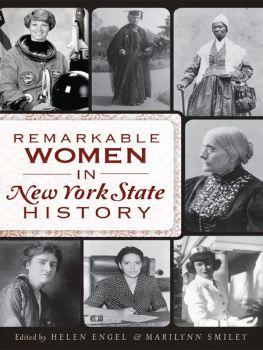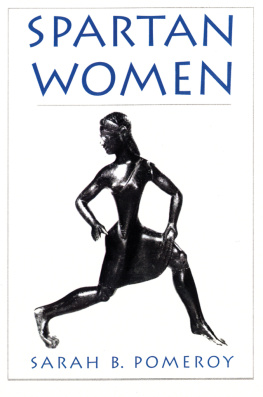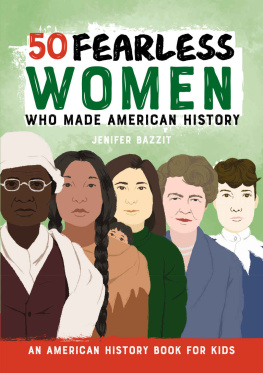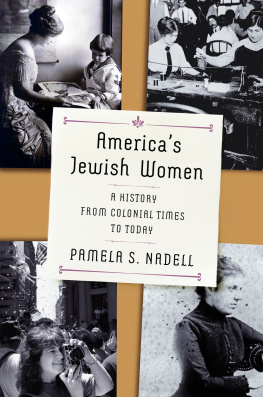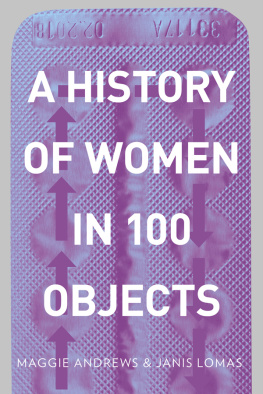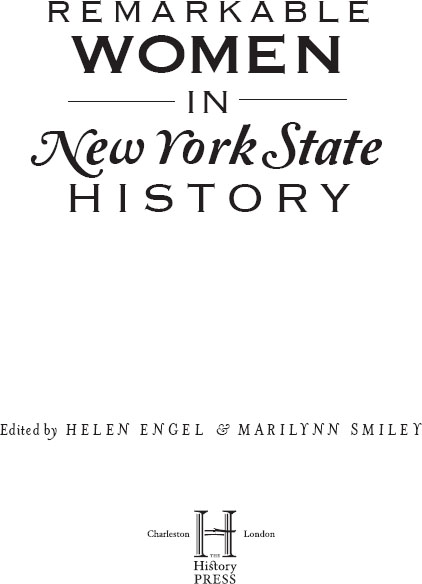
Published by The History Press
Charleston, SC 29403
www.historypress.net
Copyright 2013 by the American Association of University WomenNew York State Inc.
All rights reserved
First published 2013
e-book edition 2013
Manufactured in the United States
ISBN 978.1.62584.033.2
Library of Congress CIP data applied for.
print edition ISBN 978.1.60949.966.2
Notice: The information in this book is true and complete to the best of our knowledge. It is offered without guarantee on the part of the authors or The History Press. The authors and The History Press disclaim all liability in connection with the use of this book.
All rights reserved. No part of this book may be reproduced or transmitted in any form whatsoever without prior written permission from the publisher except in the case of brief quotations embodied in critical articles and reviews.
CONTENTS
ACKNOWLEDGEMENTS
Many thanks to all the authors who identified women in their communities and took the time to research and write about them; to all participating branches; to the Syracuse Branch for its monetary donation to help fund this project; and to the American Association of University Women of New York State (AAUW NYS) Board members for their continued support throughout this project.
Special thanks to Eleanor Filburn, Emily Oaks, Ronald Engel, Carlie Marie Engel, Mary Lou Davis and Edwina Martin for their efforts in helping us complete this book.
INTRODUCTION
Many women of New York State have truly made a difference in their professions, their communities, the state and the nation. Realizing that some have received little or no recognition for their accomplishments outside their own locality, while others have enjoyed national reputations, the members of the American Association of University Women of New York State (AAUW NYS) have written about women who have made a difference in their own communities and beyond. Members sent biographies of some well-known women, and many who are not recognized outside their own communities. Other members sent their autobiographies. Each of these women is important in her own way.
Biographies include women from the past and present, AAUW members and nonmembers, professional women in many fields, community leaders and activists. The time span is from the 1700s to today. It would be impossible to chronicle all the contributions of women in New York State in one volume, but this book is representative of what women have done and are still doing. It is unique since it features women from many walks of life over a long period of time. Members of AAUW NYS hope you enjoy learning more about these outstanding women.
REMARKABLE WOMEN IN NEW YORK STATE HISTORY
DORIS ALLEN
1921
EDUCATOR/POLITICIAN

Doris Caroline Brown was born on September 30, 1921, on her parents farm in Redfield, New York. She was the youngest of three children of David and Agnes Brown. She had a sister, Agnes (Aggie), and a brother, David (Buck).
In her memoir, Yesterdays, she described life on the farmthe hard work and the isolation, especially in winter, when snowstorms shut them off from the outside world. There were no snow ploughs yet. The snow was tamped down by horses pulling a roller. Families needed to entertain themselves. Sometimes neighbors would get together to socialize and maybe hold a dance in someones home. During the summers, there would be swimming, picnics, family reunions and trips to Redfield. As a small child, Doris went to see a traveling group perform Uncle Toms Cabin. That was when she fell in love with the theater. For weeks afterward, she would act out all the roles in the privacy of the barn. She loved little Eva most of all and fashioned blond curls by splitting dandelion stems and attaching them to her own Dutch boy haircut.
Grade school ran from first through eighth grades and started at age seven. Doris and Buck walked one mile to the one-room schoolhouse. One teacher taught all the grades. Doris knew how to read before she entered first grade. Her teacher realized that the school library of one bookshelf, where the books were the same from year to year, did not meet Doriss needs. She brought books from a local library for her. Fridays were set aside for recitations and sometimes for plays. The teacher had the students memorize poems and recite them in front of the class, teaching them to speak clearly. Doris liked to hold her fellow students attention, a skill she put to use later in life as she entered politics. In grade seven, the teacher brought books on Greek and Roman civilization, preparing Doris for the eighth-grade history regents, which students had to pass to enter high school. Doris got a perfect score.
Doris entered the Redfield Union High School in the fall of 1934, the first in her family to get a secondary education. She excelled in all areas. Her favorite subjects were English and history. Her father was a highly intelligent, self-taught man who also had a keen interest in history. He read the newspaper every day, and with the advent of rural electrification, the family got a radio. They listened to Lowell Thomas every evening. Politics and current events were discussed around the dinner table. This was during the Depression. Doris admired President Roosevelt and became a lifelong Democrat.
In high school, Doris was active in 4-H and performed in operettas. She went on an overnight trip to Cornell with 4-H. This event marked the beginning of her love of travel. At graduation in 1938, Doris was valedictorian of her class. She had skipped two grades in elementary school and was only sixteen years old.
She entered Oswego Normal School in the fall of the same year. Hers was the first group to graduate after the school became a four-year college (Oswego State Teachers College). She threw herself into her studies and loved every minute of it. She also tried many activities outside the classroom. She settled for the Debate Society, was a soloist with the choir, was on the Womens Athletic Council and worked all four years on the school newspaper, the Oswegonian, becoming its first female editor in chief in her senior year, 194142. She was on the deans list every semester. As a member of the newspaper staff, Doris went on a trip to Columbia University for a conference. She decided then that Columbia was the place where she would get her masters degree. Doris graduated from Oswego State Teachers College in 1942. She was salutatorian of her class.
Her first job was in Whitesboro, New York, as a kindergarten teacher. While she was there, she encouraged her fellow teachers to start a union. After two years at Whitesboro, Doris did go to Columbia University, receiving her MA in education in 1946. While she was at Columbia, she wrote a booklet on the History of Redfield. It was chosen by five hundred students for reading. The book was republished by the Halfshire Historical Society in Redfield in the 1980s and is still in print.
Doris returned to Oswego in 1946 and became an associate professor, master teacher and demonstrator for the kindergarten class at the Campus School of the Oswego State Teachers College. The same year, she had a textbook published: Bardeens Stories and Studies for Children in Reading.
The following year, Doris married Edwin (Jiggs) Allen. He had returned from the war and was advertising manager for the Palladium-Times, Oswegos daily newspaper. She stayed home for ten years, from 1947 to 1957, to raise their three children: Elizabeth, John and Phyllis.
Next page
